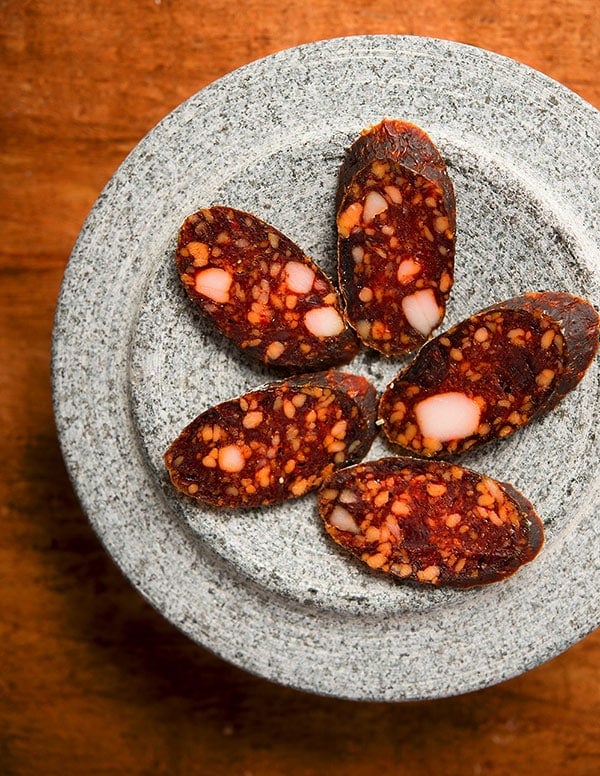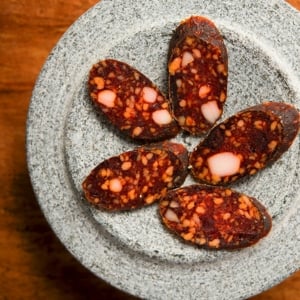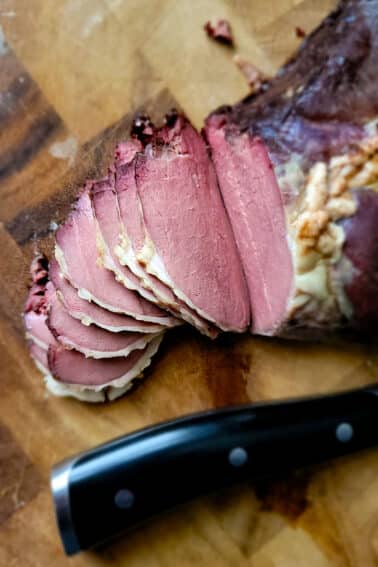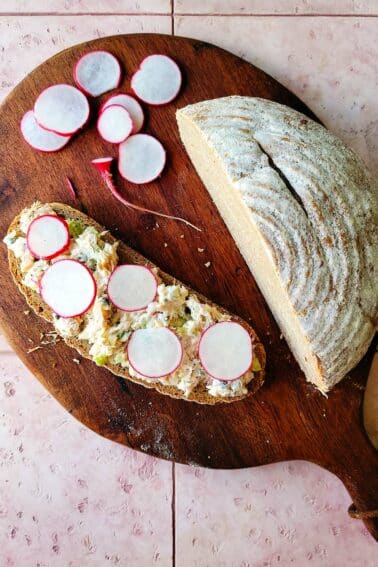As an Amazon Associate I earn from qualifying purchases.

I’d be lying if I told you that this was some secret, authentic Hungarian salami recipe. It ain’t. But if you like those smoky dried Magyar salamis you can get at places like Cleveland’s West Side market or on the Upper East Side of Manhattan, this is for you.
I’ve eaten a lot of these sausages over the years, and they all share a few things in common: Garlic, smoke and lots and lots of real Hungarian paprika. Some are spicy, some mild, some tangy, some so fatty they feel creamy when you eat them. The best examples from Hungary to my mind are the salamis from Bende and Pick, and this recipe is more or less shooting for that.
When I say real Hungarian paprika, I mean it. There is a difference in flavor between the admittedly good California paprika and the Magyar stuff. This recipe uses both sweet and hot paprika, and quite a bit of it, so you might as well get the good stuff. Oh, and this is most definitely not Spanish smoked paprika, which, while awesome, makes a Spanish sausage, not a Hungarian one.
This is a salami recipe, not a recipe for a fresh sausage. That bears repeating. It’s not for beginners. If you are not an experienced maker of fresh sausages, I don’t recommend that you make this. It is a technical deal, and considering that this is uncooked, fermented meat, you don’t want to mess around.
You will need a few things before you even start:
- The obvious: Meat grinder, sausage stuffer, casings, kitchen scale etc.
- Instacure No. 2 and a bacterial starter culture.
- A humidifier, or a place where the humidity at least 85 percent.
- A place to hang your sausages in a cool, humid environment that is around 75 percent humidity and about 55°F.
- A smoker. This is a smoked salami.
- Another useful tool is a laser thermometer, which lets you take something’s temperature instantly. I use a BAFX Products thermometer and I like it a lot.
The basic method for this salami is to make your fresh sausages, ferment them, smoke them and then hang in a cool, moist place until they’re ready. Ready means the links have lost about 30 percent of initial weight. I no longer weigh my salami this precisely, but it’s a good idea to do so until you get “the eye.”
What will you get when you are done? A rich, intensely flavorful dried Hungarian salami that is “meat forward,” meaning that the flavor of the meat and fat are the main stars — so use good meat — with the flavors of the paprika and garlic playing backup. I eat this salami as part of a charcuterie plate, but also as road food (screw you, McDonalds!) or as a snack whenever I am hunting or fishing.
Hungarian Paprika Salami
Ingredients
- 3 1/2 pounds pork, , duck, venison, etc
- 1 1/2 pounds pork belly or fatty pork shoulder
- 51 grams (about 3 tablespoons) kosher salt
- 1 tablespoon sugar or dextrose
- 6 grams (about a teaspoon) Instacure No. 2
- 6 garlic cloves, minced
- 4 tablespoons Hungarian sweet paprika
- 1 tablespoon Hungarian hot paprika
- 2 tablespoons black pepper, coarsely cracked
- 5 grams (about 1 tablespoon) starter culture T-SPX
- 1/3 cup distilled water
Instructions
- Chill the meat and fat in the freezer for at least 1 hour. You want it close to frozen, even a little crispy cold. Chop the meat and fat into chunks that will fit into your grinder, but leave about 1/3 pound of the fat aside. Cut this into small dice the size of a typical frozen carrot.
- Put about 10 feet of hog casings into some warm water and set aside.
- Mix all the spices, salt, curing salt and sugar with the meat and fat -- except for the diced fat. Put the meat mixture and the diced fat into the freezer until it's between 27°F and 36°F.
- Grind everything but the diced fat through the fine die on your grinder. If you are using trim from a deer or other animal — meaning there’s a lot of silverskin, etc — grind first through the coarse die, then again through the fine die. If you need to double-grind, chill the meat in the freezer between grindings for 15 to 20 minutes. Put the meat and the diced fat into the fridge and clean up the grinder.
- Meanwhile, run warm water through your hog casings. This flushes them, and will show you any leaks in the casings. Set them aside when you’re done.
- Take the temperature of the meat: If it is warmer than 38°F, put it back in the fridge for 30 minutes and check again. When the meat is good and cold, get your starter culture ready. Gently mix the starter culture with the distilled water and let it sit for 5 minutes. Take out the meat and put it in a mixer bowl with the heavy paddle attachment. Add the starter culture and the diced fat, then mix everything on the lowest setting for 1 to 2 minutes. You will see the meat change texture. You are looking for a good bind, where the meat is beginning to stick to itself.
- Put the meat into your sausage stuffer and stuff it into the hog casings. You want individual sausage links of about 12 to 14 inches. Leave a lot of casing on each end, because you will tie the ends of each link together to for a long loop, like a Polish kielbasa. Hang the links on a drying rack — a wooden clothes drying rack is excellent for this — and find a needle. Heat the tip of the needle over a flame until it glows; this sterilizes it. Prick the casing anywhere you see air pockets. The casing should shrink back against the meat.
- Now you need to ferment the sausage. You will want to tent the hanging sausages with black plastic from some garbage bags, or some other plastic sheeting. If you have one, put a humidifier under the sausages. You really want them to stay moist. Let the sausages hang for at least 24 hours, and up to 48 hours. Every 6 to 12 hours, spritz them with a spray mister to keep them moist. This is the fermentation stage, the stage where the starter culture you are using defeats any bad bacteria in the sausage.
- When the sausages are ready, fire up the smoker. Put ice cubes in the water tray to keep the temperature as cool as possible. You are not cooking the links here, you are giving them a good smoking. Use cherry, apple, or oak if you can. Avoid mesquite, as it is too distinctive. And no pine — too much resin. Smoke the links for at least 3 hours, making sure the temperature stays below 85°F. You can smoke the salami up to 8 hours if you like a really smoky link.
- Now you need to hang the links in your drying chamber. I use an old fridge with a temperature regulator and a humidifier in it. Hang the links at about 75 to 80 percent humidity for at least a month before eating. You can let them go as long as 3 months. Store in the fridge, or vacuum sealed in the freezer.
Notes
Nutrition
Nutrition information is automatically calculated, so should only be used as an approximation.





Hank,
I’m about to try out this recipe – noticed there’s no wine in it – Have you ever tried adding it?
Thanks for sharing these,
Rob
Rob: Yes, I’ve use wine in this recipe. Add maybe 1/2 cup cold red wine, and up to another 1/2 cup of ice water.
Thanks I’ll try some! Appreciate your response!
I also use thicker beef casings. 3-1/2 diameter x 24″ … Since I peel and discard the casings off after curing, would that be an alternative time to cold smoke the product since it can occur without the casings on the product?
Rob
Hank, if you’ll permit me, here’s a link to our website, to a series of posts that we ran back in 2016 on how to design and build fermented sausage equipment. Being an engineer, I probably have gone overboard on this, but dang it, it works, and costs less than a hundred bucks!
https://sausageswest.com/sausage-making-sausage-recipes-sausage-making-hobbyists/not-sausage-making-home-page-close/forum-website-contents/project-a-2016/project-a-introduction/project-a-2016-1-background-control-theory/
Ideal for this Hungarian recipe. Thanks!
Hello Hank,
Absolutely love your recipes, just got into smoking and curing so these have been excellent for beefing up our interests… Just curious as to how you go about regulating your humidity inside your temp controlled fridge? I have all the means to make a similar set up (have not attempted this recipe yet) but was just wondering if you could add any info to that?
Thank you!
Carter: There is a humidifier in the fridge.
Hi I need help. We have alot of deer sausage mixed with pork. In all we used way too much paprika by accident. Is there anything I can do when cooking it to mask the paprika?
Hi Hank,
Do you leave the humidity at 75-80% the entire time, or is there a ramp down schedule that you should follow if you go beyond 1 month?
Brian: I never ratchet the humidity below 65%.
Drying chamber with 75 – 80% humidity….and what temperature ?
This is first use my new fridge drying chamber and every details is important.
Thank you.
Kris: Around 50 to 55 degrees Fahrenheit.
Does this produce a nice dry sausage? Many home charcutier in Hungary produce sausages that are rather moist (can be compressed between the fingers), but most meat market or commercial kolbasz , eg Gyulai, are quite firm, close the the firmness of a ‘regular’ salami and slice without fraying or disintegrating. I find this character – a firm kolbasz quite a bit more attractive both to the tooth and to the pot. I’ve generally assumed the softness of home charcuterie, not having any real knowledge on the matter to be a defect of technique.
I’m living in S.W. Florida and I’m originally from Toledo, Ohio. There is an Hungarian meat market called Takacs that make Paprika Salami prior to the Christmas Holiday. They also make Hurka, smoked and fresh Kolbazs.
I am in South Africa was on the look out for a good salami recipe. Thanks you helped a lot. I would like to get hold of the umai plastic curing bags for meat please someone help.
I am putting together my cold smoker venturi this week and I plan on making this recipe in 2 weekends. This looks and sounds amazing, so I’m really looking forward to it.
Thank you for information. I made same kind of salami almost 4 month ago, however, still they are soft. The room temp and humidity have been controlled 14 C and 65 ~ 75 %. Do you have any idea why ?
I may never actually make this, or if I do, it won’t be until after my children are older so I actually have some time on my hands, but congratulations on your salami. The bubbles of fat seeping out of that slice made my mouth water like crazy, and I’m with totally you on using salami as road food.
@Erik
I have used the UMAI Dry with great success, I really love it. It definitely takes some getting used to, but once you get it down, its awesome.
I wanted to build a curing chamber but I just didn’t have the money (college student on a budget) so my dad told me to use the UMAI. He uses it for dry aged steaks and he loves it.
I have made Spanish Chorizo from the Polcyn/Ruhlman book and it was excellent. I have not yet figured out how to make smoked cured sausage with it yet though.
Best of luck,
Chris
Hi Hank-
Have you ever used the UMAi curing vac bags to dry cure salami in the refrigerator? I haven’t but I am curious if you have an opinion on them. It appears they reduce some of the challenges regarding environmental conditions for the dry cure period. Any thoughts?
Thanks for all the great information on your website.
Erik
Chosen Frozen in Minnesota
Hi Hank, I really loved this post. I remember eating a Romanian version of this Salami, the Sibiu salami, which as far as I know is made with a mixture of ground pork and horse meat. Great post!
There’s a place in Littlerock (middle-of-nowhere) north of LA on the way to Las Vegas called Valley Hungarian Sausage & Meat Company that sells a version of this. I have been dying to find a recipe. Thanks Hank!! You’re awesome!
Hi Hank,
I am reading your blog time to time. I like it. Today I was very surprised to read about Hungarian Paprikás Szalami. I have to admit I am Hungarian and at this moment I am in Thailand. Please tell me how come that you have eaten so many szalámi. What made you try it?
My very favorite is the Hunagrian Paprikás szalami (the hot, spice version). I will see and compare your version with the version I found in an old Butcher Trade Association’s book.
Thanks for the recipe!
Best regards,
Sándor Csata